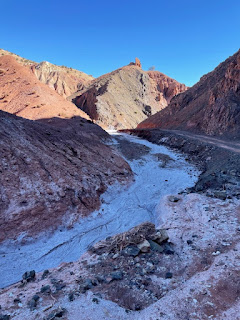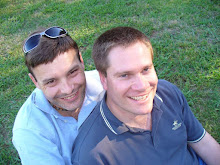We book a two-day private guided tour through the Altas Mountains to help make the most of our limited time in Morocco. This tour took us through the mountains, visiting fortified Bedouin towns, stunning kasbahs and a desert oasis. By the time we returned to Marrakech, we’d driven more than 500 km.
Addellatif, our driver and guide, picked us up from our Riad shortly after 8:00am. We’d requested an early start to get the most out of the daylight hours. This proved to be a smart move. We enjoyed a blockbuster sunrise over the Atlas Mountains while driving through some incredibly spectacular foothills. Around every corner, desert haze lit up the early rays as they slowly penetrated the deep valleys below.
We stopped briefly for a light lunch shortly before reaching Tizi n’Tichka, a mountain pass, which at 2260 metres, marked the highest point of our journey. The final stretch of highway to the summit included a spectacular series of switchback turns. Our guide stopped at a lookout where we could soak in the desolate mountainscape and marvel at the engineering skill required to build such as road.
We then turned off the main highway and made our way through the picturesque Ounilla Valley. The road winds its way through dry, barren and fragmented rock canyons, each more photogenic than the last. Our guide explained how villages used subterranean groundwater along the river and river flats to sustain their existence. Adobe brick made from local red mud and straw is the primary building material.
As a result, everywhere we drove, we’d encounter flat-roofed red brick buildings nestled on the hillside, sitting above the river’s ancient flood line. As time the scene was something straight out of a classic Hollywood film. Scars from the recent earthquake were also visible.
Thousands were killed by the quake in 2023 when entire abode villages collapsed or were flattened by landslides that crushed and buried their occupants. In response to this disaster, the Government has funded rebuilding programs using more robust concrete block construction. As a result, many villages were randomly dotted with distinctive grey buildings amidst their red brick neighbours. In places, entire neighbourhoods consisted of these new grey constructions.
Our guide took us on a detour to view one of the area’s ancient salt mines. The hills in many places are streaked by veins of white salt. We followed the path of a stream whose bed was awash with ribbons of salt until we stumbled up the mine’s decaying ruins. By chance, we discovered one intact salt crystallization pond once used to dry the briny water and extract its salt. Long crystal shards spectacularly rimmed the pond.
However, our next stop was the highlight of our day. The fortified adobe village of Ait Benhaddou is one of Morocco’s most iconic sights. For more than half a century this hillside village has been the backdrop for a myriad of Hollywood blockbusters. Known as a ksar, or fortified village, it was an important rest stop on a former caravan trading route between the Sahara and Marrakesh.
Today, the ksar itself is only sparsely inhabited by several families.
The depopulation over time is a result of the valley's loss of strategic importance in the 20th century. Most local inhabitants now live in modern dwellings in the village on the other side of the river, and make a living off agriculture and especially off the tourist trade.
We hired a local guide to take us through the village and up to the granary store that caps the hill upon which the village is built. Our visit coincided with construction work for a new movie. Film crews are banned from filming in the village itself. As a result, movie studios erect temporary structures on the outskirts, using the real village as a dramatic backdrop. Incredibly, an entire fake fort was being constructed alongside the village’s actual Kasbah fort.
Our guide explained that dozens of movies including Games of Thrones and Gladiator were filmed here. He was once hired as an extra for Gladiator. That's him on set in the photo above. Apparently, an entire amphitheatre was built for the movie. Then, once filming was completed, as per local ordinances, the entire structure was removed. A similarly spectacular sound stage was being constructed on the same site during our visit.
Our guide explained the importance of the village granary that crowned the local hilltop. In ancient times, the granary was considered a strategic and critical structure. It housed the entire village's annual harvest and kept it fed through the lean winter months. In essence, if you controlled the town's granary you controlled the population. As a result, granaries were typically built on high ground and heavily fortified to protect them from invaders. Sadly, the granary at Ait Benhaddou was destroyed in the 2023 earthquake. However, our guide told us it was scheduled for rebuilding later this year.
Honestly, Ait Benhaddou was every bit as dramatic and memorable as the best of Oman’s restored forts that we visited more than a decade ago. My photos barely do it justice. We finally finished our day with an hour-long drive to Skoura, a sprawling oasis in the Ouarzazate Province. Follow
this link to learn about our adventures in the oasis.



























No comments:
Post a Comment